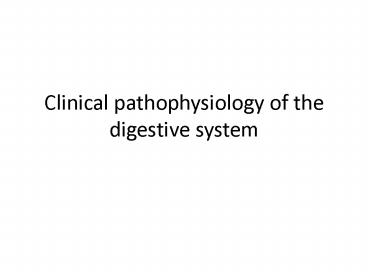Clinical pathophysiology of the digestive system - PowerPoint PPT Presentation
1 / 44
Title:
Clinical pathophysiology of the digestive system
Description:
Clinical pathophysiology of the digestive system Clinical syndromes in liver injury Lack of liver disorders ... (involved in carbohydrate, fat, protein ... – PowerPoint PPT presentation
Number of Views:171
Avg rating:3.0/5.0
Title: Clinical pathophysiology of the digestive system
1
Clinical pathophysiology of the digestive system
2
Disorder of stomach secretory function
- According to mechanism
- Organic disturbances of stomach glands
- Change I functional activity of secretory cells
- According to kind of disturbance
- Hypersecretion
- Hyposecretion
3
Key-points for hypersecretion
4
- The four inputs to parietal cells that regulate
acid secretion - by controlling the transfer of the H,K-ATPase
pumps in - cytoplasmic vesicle membranes to the plasma
membrane.
5
Gastritis
6
Gastritis
7
Disorder of stomach motor function
- Hypercinesis increased motility
- Hypertonus increased degree of contraction
- Hypocinesis - decreased motility
- Hypotonus - decreased degree of contraction
- Pathological reflexes
- Nausea
- Vomiting
- Belching
8
(No Transcript)
9
(No Transcript)
10
(No Transcript)
11
(No Transcript)
12
Gastric Juice Secretion, Mucosal Protection and
Risk of Ulcer
13
Gastric Juice Secretion, Mucosal Protection and
Risk of Ulcer
14
Gastric Juice Secretion, Mucosal Protection and
Risk of Ulcer
15
(No Transcript)
16
(No Transcript)
17
Disorders After Stomach Surgery
18
Disorders After Stomach Surgery
19
Disorder of digestion in intestine
- Disorders of the pick out of bile and pancreatic
juice are accompanied by disorders of all types
of digestion, development of putrefaction and
fermentation in the intestine (at closing, or
squeezing the excretory ducts of glands in cystic
fibrosis mucoviscidosis, because of pancreatic
cancer, acute and chronic pancreatitis and
duodenitis, violating the neurohumoral mechanisms
of regulation of secretion, particular functions
of the vagus nerve, the allocation of secretin,
cholecystokinin, pancreatic polypeptide). - Disorders of digestion of nutrients combined in
maldigestion syndrome. - Malabsorption of substances in the gut combined
into a syndrome, which is characterized by
diarrhea, weight loss, protein deficiency, signs
of hypovitaminosis.
20
(No Transcript)
21
Causes of Acute Pancreatitis
22
Consequences of Acute Pancreatitis
23
Causes of Chronic Pancreatitis
24
Consequences of Chronic Pancreatitis
25
(No Transcript)
26
(No Transcript)
27
Causes of Constipation
28
Consequences of Constipation and
(Pseudo-)Obstruction
29
Etiology and pathogenesis of liver insufficiency
- Infectious agents (hepatitis B virus,
tuberculosis bacillus, helmints) Hepatotropic
poison (drugs - tetracycline, sulfonamides,
industrial poisons - carbon tetrachloride,
arsenic, chloroform, vegetable poisons -
aflatoxin, muscarine) Physical impacts
(ionizing radiation) Biological drugs
(vaccines, serums) Violation of blood
circulation (thrombosis, embolism, venous
congestion) Endocrine pathology (diabetes
mellitus, hyperthyroidism) Tumors Hereditary
ensymopathy
30
Causes of Liver Failure
31
Consequences of Liver Failure
32
Fibrosis and Cirrhosis of the Liver
33
Fibrosis and Cirrhosis of the Liver
34
Clinical syndromes in liver injury
- Lack of liver disorders manifested
- its functions lesion metabolic (involved in
carbohydrate, fat, protein metabolism, metabolism
of vitamins, hormones, biologically active
substances) protection (phagocytic and
antitoxic) digestive and excretory (the
formation and release of bile) hemodynamic
(involved in maintaining systemic circulation).
35
Cholelithiasis Abnormal Cholesterol to Bile
Salt Ratio
36
Clinical syndromes of jaundice
- Acholia associated with non-receipt of bile in
the intestine due to violations of the formation
and outflow of bile. Acholia manifested disorders
of digestion and absorption of fats,
hypovitaminosis A, E, K, decreased intake of
unsaturated fatty acids of phospholipids to build
cell membranes, intestinal motility violation,
increasing decay and fermentation. - Dyscholia - violation of the physical-chemical
properties of bile, causing it acquires the
ability to form stones (due to genetic
predisposition, poor nutrition, metabolic
disorders, infectious-inflammatory processes,
cholestasis).
37
Cholelithiasis Abnormal Cholesterol to Bile
Salt Ratio
38
(No Transcript)
39
(No Transcript)
40
(No Transcript)
41
(No Transcript)
42
Etiology and pathogenesis of jaundice
- Jaundice - a syndrome caused by an increase in
blood bilirubin (hemolytic, parenchymal,
mechanical). - In hemolytic jaundice due to destruction of a
large number of red blood cells accumulate
indirect, protein bound bilirubin. - When parenchymal jaundice disturbed capture, and
excretion of bilirubin in hepatocytes due to
their injuries. - In mechanical jaundice occurs outflow obstruction
of bile, compression of biliary tract tumor or
scar, closing within a stone, worms, thick bile.
43
Mechanisms and Consequences of Cholestasis
44
Methods of experimental study of liver pathology
- hepatic-cell failure simulating full or partial
removal of the liver, the introduction of poisons
(carbon tetrachloride, chloroform,
trinitrotoluene) cholestatic model obtained by
squising bile ducts by ligature hepatic
vascular insufficiency simulating by overlapping
portocaval anastomosis, ligation portal vein,
hepatic vein, hepatic artery.































